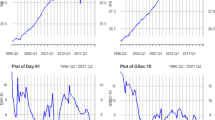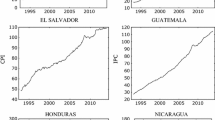Abstract
The paper analyzes empirically the money-price link for the case of Malaysia using quarterly data from 1978 to 2006. Looking at the correlations between cyclical components of monetary aggregates (M1, M2 and M3) and of the price level, we note that the significant correlations documented between money and price during 1978–1987 tend to disappear or become perverse during late 1980s and 1990s. However, for the case of M2 and M3 monetary aggregates, their significant relations with the price level reemerge during 1998–2006. While time series analyses of cointegration and vector autoregressions (VAR) are uncertain in suggesting the pre-1998 relations between broader monetary aggregates (M2 and M3) and the price level, we note the declining role of M1 monetary aggregate in anticipating future variations in the price level for the recent sample. However, the significant causal influences of M2 and M3 are apparent post-1998. Our results further suggest 4–6-quarter lagged effect of monetary aggregates on the price level. We tend to conclude that the broad monetary aggregates especially M3 is useful for the conduct of monetary policy.





Similar content being viewed by others
Notes
Another well known band-pass filter is the BK filter proposed by Baxter and King (1999). However, the use of the BK filter unnecessarily shortens our cyclical series and, consequently, constraints our sub-sample analyses. The CF filter, however, dominates the BK filter since it “fully exploits the entire data set” (Christiano and Fitzgerald 2003, p. 459) and there is no loss of observations.
The cross-correlations are computed for 10-quarter leads and lags. Given that the maximum correlations are attained at lag 5 or less, we report only up until 5-quarter leads and lags.
To conserve space, the results are not reported but available from the author upon request.
An alternative ordering is to place the monetary variable last. This ordering presumes that the monetary authority is forward looking anticipating changes in inflation and real activity.
References
Altimari N (2001) Does money lead inflation in the euro area? ECB working paper no. 63
Bahmani-Oskooee M, Rehman H (2005) Stability of the money demand function in Asian developing countries. Appl Econ 37:773–792
Bahmani-Oskooee M, Wang Y (2007) How stable is the demand for money in China? J Econ Dev 32(1):21–33
Batini N, Nelson E (2001) The lag from monetary policy actions to inflation: Friedman revisited. Int Financ 4(3):381–400
Baxter M, King RG (1999) Measuring business cycles: approximate band-pass filters for economic time series. Rev Econ Stat 81:575–593
Cacy JA (1985) Recent M1 growth and its implications. Econ Rev 70:18–24
Christiano LJ, Fitzgerald TJ (2003) The band pass filter. Int Econ Rev 44:435–465
Davis EP, Fagan G (1997) Are financial spreads useful indicators of future inflation and output growth in EU countries? J Appl Econom 12:701–714
Emery KM (1996) The information content of the paper-bill spread. J Econ Bus 48:1–10
Estrella A, Mishkin FS (1997) Is there a role for monetary aggregates in the conduct of monetary policy? J Monet Econ 40:279–304
Friedman BM (1988) Monetary policy without quantity variables. Am Econ Rev 78(2):440–445
Friedman BM, Kuttner KN (1992) Money, income, prices, and interest rates. Am Econ Rev 82(3):472–492
Friedman BM, Kuttner KN (1993) Another look at the evidence on money-income causality. J Econom 57(1–3):189–203
Gochoco-Bautista MS (2006) An assessment of the usefulness of money for policy in the Philippines. Asian Econ Pap 5(1):142–176
Goldfeld S (1976) The case of missing money. Brook Pap Econ Act 3:683–730
Gouveia S, Correia L (2008) Business cycle synchronization in the Euro area: the case of small countries. Int Econ Econ Policy 5(1–2):103–121
Harding D, Pagan A (2002) Dissecting the cycle: a methodological investigation. J Monet Econ 49:365–381
Hess GD, Porter RD (1993) Comparing interest rate spread an money growth as predictors of output growth: granger causality in the sense of granger intended. J Econ Bus 45(3–4):247–268
Higgins B (1992) Policy implications of recent M2 behavior. Econ Rev 77:21–37
Hodrick R, Prescott E (1997) Postwar U.S. business cycles: an empirical investigation. J Money Credit Bank 29:1–16
Johansen S (1988) Statistical analysis of cointegrating vectors. J Econ Dyn Control 12:213–254
Johansen S, Juselius K (1990) Maximum likelihood estimation and inference on cointegration, with application to the demand for money. Oxf Bull Econ Stat 52:169–210
Kawai M (2002) Exchange rate arrangements in East Asia: lessons from the 1997–98 currency crisis. Monet Econ Stud 52(S-1):167–204
Lee J (1997) Money, income and dynamic lag patterns. South Econ J 64:97–103
Mallick SK, Mohsin M (2007) On the effects of inflation shocks in a small open economy. Aust Econ Rev 40(3):253–266
Masih AMM, Masih R (1998) Does money cause prices, or the other way around? Multi-country econometric evidence using error-correction modeling from Southeast Asia. J Econ Stud 25(3):138–160
Miyao R (1996) Does a cointegrating M2 demand relation really exist in Japan? J Jpn Int Econ 10:169–180
Miyao R (2005) Use of the money supply in the conduct of Japan’s monetary policy: re-examining the time-series evidence. Jpn Econ Rev 56(2):165–187
Moreno R, Glick R (2001) Is money still useful for policy in East Asia? Pacific basin working paper series, Federal Reserve Bank of San Francisco, Working paper No. PB01-12
Ng S, Perron P (1995) Unit root tests in ARMA models with data-dependent methods for the selection of the truncation lag. J Am Stat Assoc 90:268–281
Sun H, Ma Y (2004) Money and price relationship in China. J Chin Econ Bus Stud 2(3):225–247
Yap MMC (2002) P-star, exchange rate regime and inflation determination: the Malaysian case. J Asia Pac Econ 7(3):379–407
Yoshida T, Rasche RH (1990) The M2 demand in Japan: shifted and unstable? Bank Jpn Monet Econ Stud 8:9–30
Acknowledgments
I would like to express my thanks to the two anonymous referees of the journal for providing very useful comments on the earlier draft of the paper. However, the remaining errors are my own responsibility.
Author information
Authors and Affiliations
Corresponding author
Rights and permissions
About this article
Cite this article
Ibrahim, M.H. Money-price relation in Malaysia: has it disappeared or strengthened?. Econ Change Restruct 43, 303–322 (2010). https://doi.org/10.1007/s10644-010-9097-1
Received:
Accepted:
Published:
Issue Date:
DOI: https://doi.org/10.1007/s10644-010-9097-1




